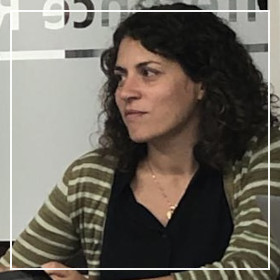After the 2011 Tunisian revolution, some of the fishermen of Zarzis – a coastal town close to the Libyan border, facing the southernmost Italian island of Lampedusa – came together to create an organisation. The walls and windows of the headquarters of Zarzis Le Pecheur (Zarzis The Fisherman) are covered in posters in Arabic and French presenting the titles, data, and photographs of all of the organisation’s activities. These portray moments as varied as young women mending nets, fishermen helping migrants disembark from their boats after a rescue operation, adults sitting behind school-like desks listening to a training session, and the wooden skeletons of boats under construction. A large table occupies much of the main meeting room, and is topped with a thick glass sheet holding in place a colorful mosaic of business-cards. These belong to the many journalists, video-makers, activists, international organisations, NGOs, cooperation and development agencies, and more who visited or worked with the fishermen over the years. Both the long meeting-room table and the walls of the headquarters speak of the fishermen’s history of engagement in attempting to salvage the fishing sector in their region, and in providing assistance to border crossers in need in the Mediterranean.
What is made and retained? What is remade and transformed? What is destroyed or lost? And what seems to be lost but remains?
Much like the fishermens’ impulse to document and display traces of their political engagements and of the networks these established, the reflections below testify to the many ways in which collective action leads to material and immaterial production, and to what participants decide to do with it in its aftermath. In the writing that follows, we attend to the materiality of objects, texts and digitally-stored artefacts, but we also draw awareness to the mnemonic “repertoire” that is held in the body. As Diana Taylor reminds us, debates about the ephemerality of performed behaviour and action are profoundly political: “Whose memories, traditions, and claims to history disappear if performance practices lack the staying power to transmit vital knowledge?” (2003: 5). Through a juxtaposition of scenes linked by activist struggle, we catalogue (without attempting to fully represent) the plethora of ways in which artefacts and embodied knowledge are entangled, and explore their potential afterlives beyond a particular moment of action. We explore the political potential of artefacts and repertoires by asking four questions: What is made and retained? What is remade and transformed? What is destroyed or lost? And what seems to be lost but remains?
What is made and retained
In the context of Syrian exile in Lebanon, characterized by brutal expulsion from home (in Syria) and illegality and political inexistence (in Lebanon), what is the relationship between memories and mundane artefacts? The older generation engaged in nightly recollections of the revolutionary momentum, tying it with episodes of ordinary life and painful losses suffered during the war. These memories were unspeakable during the day, as adults enforced a certain degree of oblivion in the children about the recent past. However, this past was also inscribed in the artefacts produced and archived by the community’s informal school. Traces or “left overs” of a revolutionary engagement resided in lived individual and collective experiences; mundane papers such as a register of the families of the camp, the school’s administrative papers, and students’ drawings constituted the archive of the life of the community. These traces indexed the loss of the (ordinary and legally-valued) past as well as the losses produced by the community’s embracing of revolution, and the affecting outcomes of the war.
But these artefacts were not only a testament to the past. For instance, the creation of school certificates for children who did not have access to formal education became a collective effort to restore a sense of normalcy in the present and to build new hopes for the future. These documents mimicked official school certificates: they were printed in colour and laminated to resist the erosion of time and the precarious conditions of the present. The certificates were conferred to students during a formal ceremony organised with care at the end of the academic year. The school courtyard was transformed into a theatre for students to perform a play, their drawings were exhibited, and school administrators offered a series of speeches to create anticipation and excitement for the final act, captured by cameras and phones from the audience: the school director inviting each student to collect their certificate.
What is remade and transformed
Although artefacts can be used synecdochally to preserve social continuity, they can also work to connect separate temporalities without arresting liveness – that is, to acknowledge that in making such a connection, the artefact can be transformed. In such cases, artefacts are reinvented with each moment, and are malleable and performative. Home Makers is a collection of soundwalks recorded and co-edited with migrant domestic workers in the UK and Lebanon. Consisting of an .mp3 file, and an instruction for listening, the soundwalks remain intact as digital artefacts. However, the soundwalks are also devices or scores for performance, which hinge the moment of creation with those occupied by listeners.
Artefacts are reinvented with each moment, and are malleable and performative.
In the soundwalk not nothing, a Filipina migrant domestic worker called Ann returns to Holland Park in central London, where she decided to escape from abusive employers. In returning to the park, she is audibly reminded of violence that took place on her last visit there, as well as routine exploitation. However, in choosing Holland Park to record her soundwalk, she was also attempting to remake or transform the space. She wanted to bump into her former employers, to show them that she had survived, and prove to them that she was “not nothing.” If space is always “caught in the ambiguity of an actualization,” the successive moments of Ann’s visits to the park with her employers, her making of the soundwalk, and the journeys of her listeners all transform Holland Park into a “practiced place” (de Certeau, 1984: 117). The digital artefact – the recording of Ann’s voice in the soundwalk itself – joins these actualisations together, but does not fully capture them. The artefact remains, but through its performance is continually remade and transformed.
What is destroyed or lost
Often, artefacts are not intended to last beyond their initial purpose – say, the communicative purpose of placards, flyers, and chant sheets on a march. Other artefacts might have a more or less indefinite life, like the artwork depicted on cardboard barricades during the Red Shirt movement in Thailand (only partially durable material, they were nevertheless lovingly dismantled and recreated in a new site when the protest moved), or the artwork painted onto newly erected concrete barriers during protests in Lebanon in 2015 (highly durable material, protestors themselves tore down the barriers mere days later, and the artwork with it). At other times the intention is to not leave a trace, or to be destroyable at a moment’s notice – like organising chains for direct actions on Signal or Telegram. More frequently, perhaps, artefacts are destroyed by one’s opponents. This might be in-built, as with the cardboard barricades, but far more often the destruction is intended to wipe the material slate clean, and so too the lives and memories of those involved, the possibility to imagine resistance with them.
Far more often the destruction is intended to wipe the material slate clean, and so too the lives and memories of those involved, the possibility to imagine resistance with them.
And then sometimes an artefact might be lost in some material sense, but that tells only part of the story. Take an example placard from the migrant worker contingent of the 2019 International Women’s Day march in Lebanon, which read I’m not your bitch, bitch!. Despite attempts to retain such material for a migrant worker community archive, this poster was lost. When one of the authors of this text lamented this fact with the woman who had held it aloft during the march, she was unperturbed: “I gave it to someone. You know, I was like everywhere on social media!”. Her photo holding that sign and shouting had, in fact, circulated widely online. “I have the picture, I can print it out”, she added. Here, the circulation of the object was widespread. The “artefact” itself is lost, but exists far more widely than in the bit of paper itself. Does its loss matter all that much? After all, it would not be too hard to make more I’m not your bitch, bitch! posters if the sentiment and the desire to communicate it are maintained, and there is enough pen and paper around.
What seems to be lost but remains
Archives are often collections of things, but what of the intangible practices and repertoires that are “collected” over time by activist(s and) ethnographers? What of the protest practices learnt through exposure? These make up particular kinds of knowledge: the right clothing for temperature, tear gas, comfort or modesty; the necessity for water, food and a backup battery pack and charger; how to dodge and duck; when and how to run; how to stay calm(er); how to chant in unison – call and response; how to shout; the rhythms of slogans and songs; the fact that mobile networks often disappear during protest (through fault or design) and planning for these eventualities.
What of the intangible practices and repertoires that are “collected” over time by activist(s and) ethnographers? What of the protest practices learnt through exposure?
There are specific ways to be and move. An awareness that develops. It is a bodily knowledge which ethnographers and activists learn through doing. The important role of onions and milk or diluted vinegar (not water!) for treating tear gas; which police stations people are taken to if there are arrests; which lawyers or activists to contact in an emergency. The related responses – fear, rage, tears, shock, apathy – before, after or during moments of political engagement. The feelings themselves may be fleeting but the memory of having made their acquaintance remains. These are the feelings that either drive action or prevent it, now and/or in the future. What to do with and about this range of responses. Should you be sure to seek out community and friendship? Do you need to be alone? Will food, cigarettes, or nature help?
This combination of pragmatic know-how and familiarity with a range of sensory facts may leave no physical trace but remain as an embodied “repertoire” for activists and ethnographers long after banners are lost, flyers abandoned, and memorials begin to fade into landscape. The repertoire remembers gestures, movements, choreographies or relationships between places and people. These aspects of both everyday commitments and of heightened moments of political engagement are non-artefactual or unarchiveable, but lie at the heart of the knowledge that is produced and passed on through both personal and collective action.
Conclusion
Networks of solidarity also remain as material and immaterial resources, as both archive and repertoire. Some of the contacts from the Zarzis fishermen’s business-card mosaic – those who had worked with them the most over the years – were called upon immediately when in August 2018 the organisation’s president and his crew were arrested near Lampedusa and accused of people smuggling. This arrest came after several summers during which the Italian government worked to dissuade and criminalise rescue at sea on the part of NGOs, merchant ships, fishing fleets, and even its own coast guard. Activist networks in Sicily mobilised to pay for lawyers – the same ones who had represented the crew of an NGO vessel who had been similarly accused in the recent past. Others liaised with people in Zarzis to gather all of the material evidence possible proving that the fishermen were known for coming to the rescue of people in danger at sea, and that this was precisely what they had been doing the day they had been arrested. The cascade of artefacts assembled was vast: training course certificates from the likes of Doctors Without Borders and the International Committee of the Red Cross, photos of life-vest and first-aid kit donations, articles, documentaries and photographs about their involvement in rescue at sea, words of praise from development agencies who had worked with them on traditional fishing projects.
Documents and relationships – an archive and a repertoire of solidarity – are visible and have material, political effect.
The fishermen and those in solidarity with them also organised a fishing strike and several protests – in Zarzis, in the capital Tunis, in Sicily, and in Paris, where the Zarzis diaspora was also quick to react – demanding the release of their arrested colleagues. After spending a month in prison, the fishermen were released and allowed to return to Tunisia, and to eventually retrieve their boat. The vast range of documentation that turned out to be crucial, for the court case could neither have been brought together nor could it have been successfully fought without embodied collective knowledge and the coming together of social relations into tangible networks that mobilised to bring the message “free the fishermen” to national and international attention.
In this mobilisation, documents and relationships – an archive and a repertoire of solidarity – are visible and have material, political effect. When the Zarzis fishermen’s lawyers presented their array of material at the hearing in Sicily, the judges were “pieni di meraviglia” (full of wonder). The fishermen’s release underscores the proposition we have made in this text that artefacts are performative and subject to various forms of action. They are made and retained, they are remade and transformed, they can be destroyed and lost, and when they seem to be lost, their power can remain. And even when invisible to a gaze focused on text and object, repertoires of action are learnt, shared and accumulated in singular and collective bodies, and can resurface despite changing temporalities and contexts of protest.
Featured image by David Julien courtesy of Pixabay.com









